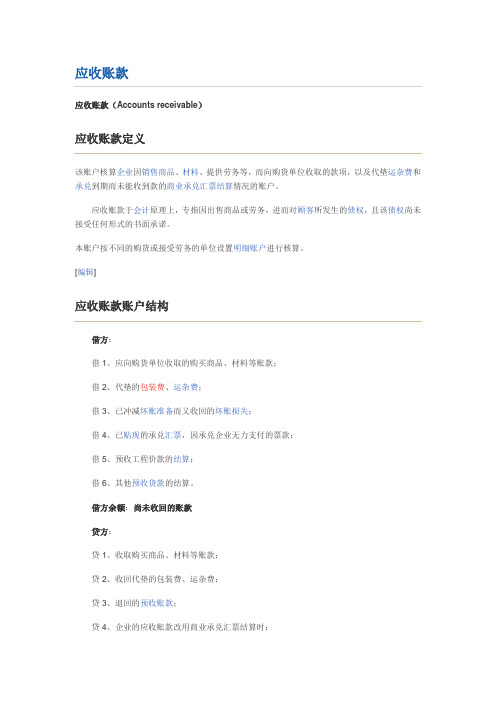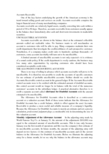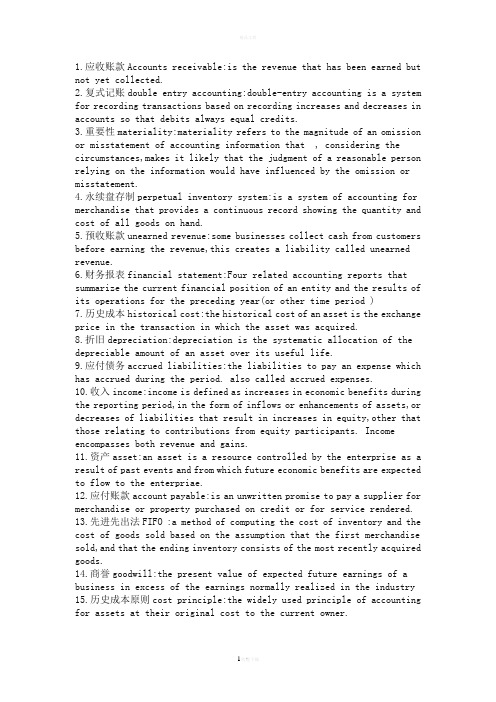Accounts receivable(应收账款)
- 格式:doc
- 大小:33.50 KB
- 文档页数:3

应收账款应收账款(Accounts receivable)应收账款定义该账户核算企业因销售商品、材料、提供劳务等,而向购货单位收取的款项,以及代垫运杂费和承兑到期而未能收到款的商业承兑汇票结算情况的账户。
应收账款于会计原理上,专指因出售商品或劳务,进而对顾客所发生的债权,且该债权尚未接受任何形式的书面承诺。
本账户按不同的购货或接受劳务的单位设置明细账户进行核算。
[编辑]应收账款账户结构借方:借1、应向购货单位收取的购买商品、材料等账款;借2、代垫的包装费、运杂费;借3、已冲减坏账准备而又收回的坏账损失;借4、已贴现的承兑汇票,因承兑企业无力支付的票款;借5、预收工程价款的结算;借6、其他预收货款的结算。
借方余额:尚未收回的账款贷方:贷1、收取购买商品、材料等账款;贷2、收回代垫的包装费、运杂费;贷3、退回的预收账款;贷4、企业的应收账款改用商业承兑汇票结算时;贷5、收到承兑的商业汇票;贷6、已转销而又收回的坏账损失。
贷方余额:向有关单位预收款项[编辑]应收账款的范围[1]应收账款是有特定的范围的。
首先,应收账款是指因销售活动或提供劳务而形成的债权,不包括应收职工欠款、应收债务人的利息等其他应收款;其次,应收账款是指流动资产性质债权,不包括长期的债权,如购买长期债券等;第三,应收账款是指本公司应收客户的款项,不包括本公司付出的各类存出保证金,如投标保证金和租入包装物等保证金等。
[编辑]应收账款的计价[1]应收账款通常按实际发生额计价入账。
计价时还需要考虑商业折扣和现金折扣等因素。
1.商业折扣应收账款商业折扣指公司根据市场需求情况或针对不同的客户,在商品标价上给予的折扣,商业折扣是企业最常用的促销方式之一。
[2]采用销量越多、价格越低的促销策略,也就是我们通常所说的“薄利多销”。
商业折扣的特点是:折扣是在实现销售时同时发生的。
它是公司在存在商业折扣销售方式时确定实际销售价格的手段.销售额与折扣额须在同一张发票上分别注明,买卖双方任何一方都不需要在各自账上单独核算。

Accounts ReceivableOne of the key factors underlying the growth of the American economy is the trend toward selling goods and services on credit. Accounts receivable comprise the largest financial asset of many merchandising companies.Accounts receivable are relatively liquid assets, usually converting into cash within a period of 30 to 60 days. Therefore, accounts receivable from customers usually appear in the balance sheet immediately after cash and short-term investments in marketable securities.UNCOLLECTIBLE ACCOUNTSAccounts receivable are shown in the balance sheet at the estimated collectible amount—called net realizable value. No business wants to sell merchandise on account to customers who will be able to pay. Many companies maintain their own credit departments that investigate the creditworthiness of each prospective customer. Nonetheless, if a company makes credit sales to hundreds—perhaps thousands—of customers, some accounts inevitably will turn out to be uncollectible.A limited amount of uncollectible accounts is not only expected—it is evidence of a sound credit policy. If the credit department is overly cautious, the business may lose many sales opportunities by rejecting customers who should have been considered acceptable credit risks.THE ALLOWANCE FOR DOUBTFUL ACCOUNTSThere is no way of telling in advance which accounts receivable will prove to be uncollectible. It is therefore not possible to credit the accounts of specific customers for our estimate of probable uncollectible accounts. Neither should we credit the Accounts Receivable control account in the general ledger. If the Accounts Receivable control accounts were to be credited with the estimated amount of doubtful accounts, this control account would no longer be in balance with the total of the numerous customers’accounts in the subsidiary ledger. A practical alternative therefore is to credit a separate account called Allowance for Doubtful Accounts with the amount estimated to be uncollectible.The Allowance for Doubtful Accounts often is described as a contra-asset account or a valuation account. Both of these terms indicate that the Allowance for Doubtful Accounts has a credit balance, which is offset against the asset Accounts Receivable to produce a more useful and reliable measure of a company’s liquidity. Because the Allowance for Doubtful Accounts is merely an estimate and not a precise calculation, professional judgment plays a considerable role in determining the size of this valuation account.Monthly Adjustment of the Allowance Account In the adjusting entry made by World Famous Toy Co. at January 31, the amount of the adjustment ($10,000) was equal to the estimated amount of uncollectible accounts. This is true only because January was the first month of operations and this was the company’s first estimate of its uncollectible accounts. In future months, the amount of the adjusting entry will depend on two factors: (1) the estimate of uncollectible accounts and (2) the current balance in the Allowance for Doubtful Accounts. Before we illustrate the adjusting entry for a future month, let us see why the balance in the allowance account maychange during the accounting period.WRITING OFF AN UNCOLLECTIBLE ACCOUNT RECEIV ABLEWhenever an account receivable from a specific customer is determined to be uncollectible, it no longer qualifies as an asset and should be written off. To write off an account receivable is to reduce the balance of the customer’s account to zero. The journal entry to accomplish this consists of a credit to the Accounts Receivable control account in the general ledger (and to the customer’s account in the subsidiary ledger) and an offsetting debit to the Allowance for Doubtful Accounts.To illustrate, assume that, early in February, World Famous Toy Co. learns that Discount Stores has gone out of business and that the $4,000 account receivable from this customer is now worthless. The entry to write off this uncollectible account receivable is:Allowance for Doubtful Accounts………………… 4,000Accounts Receivable (Discount Stores)…………………… 4,000To write off the account receivable from Discount Stores as uncollectible.The important thing to note in this entry is that the debit is made to the Allowance for Doubtful Accounts and not to the Uncollectible Accounts Expense account. The estimated expense of credit losses is charged to the Uncollectible Accounts Expense account at the end of each accounting period. When a specific account receivable is later determined to be worthless and is written off, this action does not represent an additional expense but merely confirms our previous estimate of the expense. If the Uncollectible Accounts Expense account was first charged with estimated credit losses and then later charged with proven credit losses, we would be double-counting the actual uncollectible accounts expense.Notice also that the entry to write off an uncollectible account receivable reduces both the asset account and the contra-asset account by the same amount. Thus writing off an uncollectible account does not change the net realizable value of accounts receivable in the balance sheet.INTERNAL CONTROLS FOR RECEIV ABLESOne of the most important principles of internal control is that employees who have custody of cash or other negotiable assets must not maintain accounting records. In a small business, one employee often is responsible for handing cash receipts, maintaining accounts receivable records, issuing credit memoranda, and writing off uncollectible accounts. Such a combination of duties is an invitation to fraud. The employee in this situation is able to remove the cash collected from a customer without making any record of the collection. The next step is to dispose of the balance in the customer’s account. This can be done by issuing a credit memo indicating that the customer has returned merchandise, or by writing off the customer’s account as uncollectible. Thus the employee has the cash, the customer’s account shows a zero balance due, and the books are in balance.In summary, employees who maintain the accounts receivable subsidiary ledger should not have access to cash receipts. The employees who maintain accounts receivable or handle cash receipts should not have authority to issue credit memoranda or to authorize the write-off of receivables as uncollectible. These areclassic examples of incompatible duties.MANAGEMENT OF ACCOUNTS RECEIV ABLEManagement has two conflicting objectives with respect to the accounts receivable. On the one hand, management wants to generate as much sales revenue as possible. Offering customers lengthy credit terms, with little or no interest, has proven to be an effective means of generating sales revenue.Every business, however, would rather sell for cash than on account. Unless receivables earn interest, which usually is not the case, they are nonproductive assets that produce no revenue as they await collection. Therefore, another objective of cash management is to minimize the amount of money tied up in the form of accounts receivable.Several tools are available to a management that must offer credit terms to its customers yet wants to minimize the company’s investment in accounts receivable. We have already discussed offering credit customers cash discounts (such as 2/10, n/30) to encourage early payment. Other tools include factoring accounts receivable and selling to customers who use national credit cards.应收账款一个关键因素的增长,美国经济正走向销售商品和服务的信贷。

1.应收账款Accounts receivable:is the revenue that has been earned but not yet collected.2.复式记账double entry accounting:double-entry accounting is a system for recording transactions based on recording increases and decreases in accounts so that debits always equal credits.3.重要性materiality:materiality refers to the magnitude of an omission or misstatement of accounting information that , considering the circumstances,makes it likely that the judgment of a reasonable person relying on the information would have influenced by the omission or misstatement.4.永续盘存制perpetual inventory system:is a system of accounting for merchandise that provides a continuous record showing the quantity and cost of all goods on hand.5.预收账款unearned revenue:some businesses collect cash from customers before earning the revenue,this creates a liability called unearned revenue.6.财务报表financial statement:Four related accounting reports that summarize the current financial position of an entity and the results of its operations for the preceding year(or other time period )7.历史成本historical cost:the historical cost of an asset is the exchange price in the transaction in which the asset was acquired.8.折旧depreciation:depreciation is the systematic allocation of the depreciable amount of an asset over its useful life.9.应付债务accrued liabilities:the liabilities to pay an expense which has accrued during the period. also called accrued expenses.10.收入income:income is defined as increases in economic benefits during the reporting period,in the form of inflows or enhancements of assets,or decreases of liabilities that result in increases in equity,other that those relating to contributions from equity participants. Income encompasses both revenue and gains.11.资产asset:an asset is a resource controlled by the enterprise as a result of past events and from which future economic benefits are expected to flow to the enterpriae.12.应付账款account payable:is an unwritten promise to pay a supplier for merchandise or property purchased on credit or for service rendered.13.先进先出法FIFO :a method of computing the cost of inventory and the cost of goods sold based on the assumption that the first merchandise sold,and that the ending inventory consists of the most recently acquired goods.14.商誉goodwill:the present value of expected future earnings of a business in excess of the earnings normally realized in the industry 15.历史成本原则cost principle:the widely used principle of accounting for assets at their original cost to the current owner.欢迎您的下载,资料仅供参考!致力为企业和个人提供合同协议,策划案计划书,学习资料等等打造全网一站式需求。

应收账款的管理措施Management measures for accounts receivable应收账款是指企业因销售商品、产品或提供劳务而形成的债权。
其实质就是企业因赊销产品而形成的产物。
应收账款是企业流动资产的重要组成部分。
安全、有效的加强应收账款管理,对提高企业资金使用率、降低企业经营风险具有十分重要的意义。
对于已形成的应收帐款一般采取以下措施进行管理:Accounts receivable refers to the creditor's rights that are formed by the sale of goods, products or services, which essence is the outcome formed due to the sales of products in credit. Accounts receivable is an important part of an enterprise’s liquid assets. The safe and effective enhancement of management for the accounts receivable has very important significance to improve the utilization rate of enterprise funds, and to reduce the operating risk of an enterprise. As for the receivables which have been formed generally, it generally takes the following measures for management:一、对于正常期限内的应收账款采取保理的方式盘活I. As for the accounts receivable in the normal period, it could take factoring approach to liquidize it.应收账款保理是企业将赊销形成的未到期应收账款在满足一定条件的情况下,转让给商业银行,以获得银行的流动资金支持,加快资金周转。

财务报表术语词条accelerated depreciation 加速折旧主要基于报税目的的一种折旧方法,该方法可以降低公司当期收益,进而降低支付的所得税。
Accounting policies 会计政策公司按照公认会计准则(GAAP)要求编制财务报表时采用的会计方法。
会计政策在财务报表附注中加以列示。
Accounting principles 会计准则会计师编制企业会计报表时基于的基本概念和假设。
会计准则包括,稳健原则。
历史成本原则,重要性原则,以及收入确认原则等等。
Accounts payable 应付账款公司按照各种支付条款购买商品和服务时,应向供应商支付的流动负债,也称作交易信用(应付账款)。
Accounts receivable 应收账款代表公司将于12个月之内收回的债权的一种流动资产。
通常,客户因购买商品和服务所欠款项带来的交易应收(trade receivable),代表了几乎全部的应收账款。
应收票据一般代表其他资产的销售,或者交易应收从口头账项(open account)向票据基础的转化(应收款项)(又称作receivable)。
Accrual basis 应计制,权责发生制绝大多数公司编制财务报表的依据,收入在实现(商品运送或劳务提供)时确认,为创造这些收入而招致的费用在发生时确认。
Accruals 应计额 (参见应计费用。
)Accrued expense 应计费用资产负债表上的一项流动负债,记录报告日累计的义务,如工资,职工福利,保险,到期利息,租金,销售佣金以及某些情况下,税额。
Accrued income 应计利润 (参见递延贷项。
)Accumulated depreciation 累计折旧全部折旧的累加金额,通常在资产负债表上按照固定资产历史成本的减项列示。
acid test ratio 酸性测试比率 (参见速动资产比率。
)additional paid-in capital 资本公积资产负债表上股东权益的一部分,记录股东投入的权益资本额中超过普通股账面价值的部分(又称作超过账面价值资本,资本剩余,实收资本,以及额外资本)。

往来款会计英语
往来款会计英语是指在企业或个人之间发生的借款、贷款、应收款、应付款等款项的会计英语。
在企业或个人的日常经营中,往来款是非常常见的,因此掌握往来款会计英语是非常重要的。
以下是一些往来款会计英语的常见表达:
1. 借款:borrowing;lending
2. 贷款:loan;lend
3. 应收账款:accounts receivable;receivables
4. 应付账款:accounts payable;payables
5. 收款:receipt;collection
6. 付款:payment;disbursement
7. 逾期账款:overdue accounts;past due accounts
8. 坏账:bad debts;uncollectible accounts
9. 折扣:discount;rebate
10. 还款:repayment;pay back
11. 利息:interest;interest rate
12. 收据:receipt;voucher
13. 发票:invoice;bill
14. 对账单:statement of account;account statement
15. 结算:settlement;clearing
16. 付清:settle;pay off
17. 余额:balance;remaining amount
18. 期初余额:opening balance
19. 期末余额:closing balance
掌握以上往来款会计英语的表达,可以帮助您更好地理解相关会计报表和业务操作,并且更加流畅地与外国客户或同事进行沟通。
保理、再保理方的专业名词-概述说明以及解释1.引言1.1 概述概述保理和再保理是金融领域中的两个重要概念,它们在商业活动和风险管理中起着关键作用。
这些专业名词在保理业务和再保险领域中被广泛使用,因此了解和熟悉这些名词对于从事相关行业的人来说至关重要。
本文旨在对保理和再保理方面常见的专业名词进行总结和解释。
我们将从基本概念和背景开始,然后深入介绍这些名词的定义和解释。
通过阐述这些名词的含义和用途,读者将能够更好地理解和应用它们。
在保理方面,我们将介绍保理的基本定义和起源,并解释与之相关的常见名词,如债权转让、应收账款、保理费用等。
通过了解这些名词的含义和作用,读者将能够更好地理解保理业务的运作机制和相关费用结构。
在再保理方面,我们将探讨再保理的定义和背景,并对一些常见名词进行解释,如再保险合同、再保险比例、再保险条款等。
通过深入了解这些专业名词,读者将对再保理方面的风险管理和合同安排有更全面的认识。
最后,通过总结保理方和再保理方的专业名词,我们将对这些名词进行概括和归纳,以进一步加深读者对这两个概念的理解和应用。
通过理解和掌握这些专业名词,读者将能够更好地在保理和再保理领域中进行工作和决策。
本文的目的是帮助读者更好地理解和运用保理和再保理方面的专业名词。
通过对这些名词的全面解释和案例分析,读者将能够更深入地了解保理和再保理业务的运作原理和应用场景。
希望本文能够为从事保理和再保理行业的人士提供有益的参考和指导。
1.2文章结构文章结构:本文分为三个主要部分:引言、正文和结论。
引言部分主要介绍了本文的概述、文章的结构以及目的。
通过引言,读者可以了解到本文所要探讨的内容以及目标。
正文部分包括两个小节:保理的专业名词和再保理方的专业名词。
在每个小节中,将对这两个领域的专业名词进行解释和阐述。
在保理的专业名词部分,首先会给出保理的定义和背景介绍,为读者提供基础知识。
接下来,将列举并解释一些常见的保理名词,以帮助读者更好地理解保理领域的专业术语。
英文会计科目名称表在国际贸易和跨国企业越来越普遍的背景下,英文会计科目名称表的准确性和规范化变得尤为重要。
本文将为您介绍一份包含常见英文会计科目名称的表格,并提供相应定义和解释,以便于财务人员在处理国际业务时能够准确理解和应用。
1. 资产类科目:- Cash (现金): The currency and coins held by a company or other financial institution.- Accounts Receivable (应收账款): The amounts owed to a company by its customers for goods or services.- Inventory (存货): The raw materials, work-in-progress goods, and finished goods held by a company.- Property, Plant, and Equipment (固定资产): Long-term assets such as buildings, machinery, and vehicles.- Investments (投资): The shares or bonds held by a company in other companies or entities.2. 负债类科目:- Accounts Payable (应付账款): The amounts owed by a company to its suppliers or creditors.- Loans Payable (应付贷款): The long-term loans or debts owed by a company to financial institutions.- Accrued Expenses (应计费用): The expenses that a company has incurred but has not yet paid.- Deferred Revenue (递延收益): The revenue that a company has received but has not yet earned.3. 所有者权益类科目:- Share Capital (股本): The total value of shares issued by a company to its shareholders.- Retained Earnings (留存收益): The accumulated profits or losses of a company since its inception.- Dividends (红利): The payments made by a company to its shareholders as a share of the profits.4. 收入类科目:- Sales Revenue (销售收入): The income generated from sales of goods or services.- Interest Income (利息收入): The income earned from interest on loans or investments.- Dividend Income (股息收入): The income earned from dividends received from investments.5. 费用类科目:- Salaries and Wages (工资薪金): The payments made to employees for their services.- Rent Expense (租金费用): The amount paid for the use of property or equipment.- Utilities Expense (水电费用): The cost of electricity, water, and other utilities used by a company.6. 成本类科目:- Cost of Goods Sold (销售成本): The direct costs incurred in producing or purchasing goods for sale.- Depreciation Expense (折旧费用): The allocation of the cost of an asset over its useful life.通过上述科目名称表格,我们可以看到不同类别的会计科目及其定义和解释。
应收账款外文参考文献应收账款(Accounts Receivable)是指企业向客户出售商品或提供服务,而尚未收到与之相应的货款或费用时,对客户的债权关系。
应收账款对企业的现金流和财务结构具有重要影响。
以下是一些关于应收账款的外文参考文献供参考。
1. “The Impact of Accounts Receivable on a Firm's Financial Statements” by William Y. Jiang该文研究了应收账款对企业财务报表的影响。
作者指出,应收账款增加会增加企业的总资产和所有者权益,但会降低现金和流动资产比率。
此外,作者还从财务报表的角度分析了如何更好地管理应收账款,以提高企业的偿债能力和利润率。
2. “A Review of the Theories and Empirical Evidence on the Determinantsof Trade Credit” by Maurizio La Rocca and Tiziana La Rocca该文综述了有关贸易信贷决定因素的理论和实证研究。
研究者发现,除了企业的财务状况和信誉度,客户的经营能力、行业环境和政策法规等因素也会对应收账款的管理和授信决策产生影响。
该文旨在为企业制定应收账款策略提供参考。
3. “What Drives the Use of Factoring Services by Small and Medium-Sized Enterprises?” by Päivi Kozak and Yrjö Koskinen该文探讨了小型和中型企业使用保理服务的动因和效应。
研究者发现,应收账款的催收和融资是影响企业选择保理服务的主要因素。
此外,保理服务可以减少企业的信用风险和流动性风险,提高应收账款的转化率和减少账面账款欠款。
4. “The Relationship Between Accounts Receivable Management and Corporate Profitability: Evidence from the UK” by Nurul Nadia Mohamad Amin and Tunku Salha binti Tunku Ahmad该文从英国的实证角度分析了应收账款管理与企业盈利能力之间的关系。
Accounts ReceivableOne of the key factors underlying the growth of the American economy is the trend toward selling goods and services on credit. Accounts receivable comprise the largest financial asset of many merchandising companies.Accounts receivable are relatively liquid assets, usually converting into cash within a period of 30 to 60 days. Therefore, accounts receivable from customers usually appear in the balance sheet immediately after cash and short-term investments in marketable securities.UNCOLLECTIBLE ACCOUNTSAccounts receivable are shown in the balance sheet at the estimated collectible amount—called net realizable value. No business wants to sell merchandise on account to customers who will be able to pay. Many companies maintain their own credit departments that investigate the creditworthiness of each prospective customer. Nonetheless, if a company makes credit sales to hundreds—perhaps thousands—of customers, some accounts inevitably will turn out to be uncollectible.A limited amount of uncollectible accounts is not only expected—it is evidence of a sound credit policy. If the credit department is overly cautious, the business may lose many sales opportunities by rejecting customers who should have been considered acceptable credit risks.THE ALLOWANCE FOR DOUBTFUL ACCOUNTSThere is no way of telling in advance which accounts receivable will prove to be uncollectible. It is therefore not possible to credit the accounts of specific customers for our estimate of probable uncollectible accounts. Neither should we credit the Accounts Receivable control account in the general ledger. If the Accounts Receivable control accounts were to be credited with the estimated amount of doubtful accounts, this control account would no longer be in balance with the total of the numerous customers’accounts in the subsidiary ledger. A practical alternative therefore is to credit a separate account called Allowance for Doubtful Accounts with the amount estimated to be uncollectible.The Allowance for Doubtful Accounts often is described as a contra-asset account or a valuation account. Both of these terms indicate that the Allowance for Doubtful Accounts has a credit balance, which is offset against the asset Accounts Receivable to produce a more useful and reliable measure of a company’s liquidity. Because the Allowance for Doubtful Accounts is merely an estimate and not a precise calculation, professional judgment plays a considerable role in determining the size of this valuation account.Monthly Adjustment of the Allowance Account In the adjusting entry made by World Famous Toy Co. at January 31, the amount of the adjustment ($10,000) was equal to the estimated amount of uncollectible accounts. This is true only because January was the first month of operations and this was the company’s first estimate of its uncollectible accounts. In future months, the amount of the adjusting entry will depend on two factors: (1) the estimate of uncollectible accounts and (2) the current balance in the Allowance for Doubtful Accounts. Before we illustrate the adjusting entry for a future month, let us see why the balance in the allowance account maychange during the accounting period.WRITING OFF AN UNCOLLECTIBLE ACCOUNT RECEIV ABLEWhenever an account receivable from a specific customer is determined to be uncollectible, it no longer qualifies as an asset and should be written off. To write off an account receivable is to reduce the balance of the customer’s account to zero. The journal entry to accomplish this consists of a credit to the Accounts Receivable control account in the general ledger (and to the customer’s account in the subsidiary ledger) and an offsetting debit to the Allowance for Doubtful Accounts.To illustrate, assume that, early in February, World Famous Toy Co. learns that Discount Stores has gone out of business and that the $4,000 account receivable from this customer is now worthless. The entry to write off this uncollectible account receivable is:Allowance for Doubtful Accounts………………… 4,000Accounts Receivable (Discount Stores)…………………… 4,000To write off the account receivable from Discount Stores as uncollectible.The important thing to note in this entry is that the debit is made to the Allowance for Doubtful Accounts and not to the Uncollectible Accounts Expense account. The estimated expense of credit losses is charged to the Uncollectible Accounts Expense account at the end of each accounting period. When a specific account receivable is later determined to be worthless and is written off, this action does not represent an additional expense but merely confirms our previous estimate of the expense. If the Uncollectible Accounts Expense account was first charged with estimated credit losses and then later charged with proven credit losses, we would be double-counting the actual uncollectible accounts expense.Notice also that the entry to write off an uncollectible account receivable reduces both the asset account and the contra-asset account by the same amount. Thus writing off an uncollectible account does not change the net realizable value of accounts receivable in the balance sheet.INTERNAL CONTROLS FOR RECEIV ABLESOne of the most important principles of internal control is that employees who have custody of cash or other negotiable assets must not maintain accounting records. In a small business, one employee often is responsible for handing cash receipts, maintaining accounts receivable records, issuing credit memoranda, and writing off uncollectible accounts. Such a combination of duties is an invitation to fraud. The employee in this situation is able to remove the cash collected from a customer without making any record of the collection. The next step is to dispose of the balance in the customer’s account. This can be done by issuing a credit memo indicating that the customer has returned merchandise, or by writing off the customer’s account as uncollectible. Thus the employee has the cash, the customer’s account shows a zero balance due, and the books are in balance.In summary, employees who maintain the accounts receivable subsidiary ledger should not have access to cash receipts. The employees who maintain accounts receivable or handle cash receipts should not have authority to issue credit memoranda or to authorize the write-off of receivables as uncollectible. These areclassic examples of incompatible duties.MANAGEMENT OF ACCOUNTS RECEIV ABLEManagement has two conflicting objectives with respect to the accounts receivable. On the one hand, management wants to generate as much sales revenue as possible. Offering customers lengthy credit terms, with little or no interest, has proven to be an effective means of generating sales revenue.Every business, however, would rather sell for cash than on account. Unless receivables earn interest, which usually is not the case, they are nonproductive assets that produce no revenue as they await collection. Therefore, another objective of cash management is to minimize the amount of money tied up in the form of accounts receivable.Several tools are available to a management that must offer credit terms to its customers yet wants to minimize the company’s investment in accounts receivable. We have already discussed offering credit customers cash discounts (such as 2/10, n/30) to encourage early payment. Other tools include factoring accounts receivable and selling to customers who use national credit cards.。